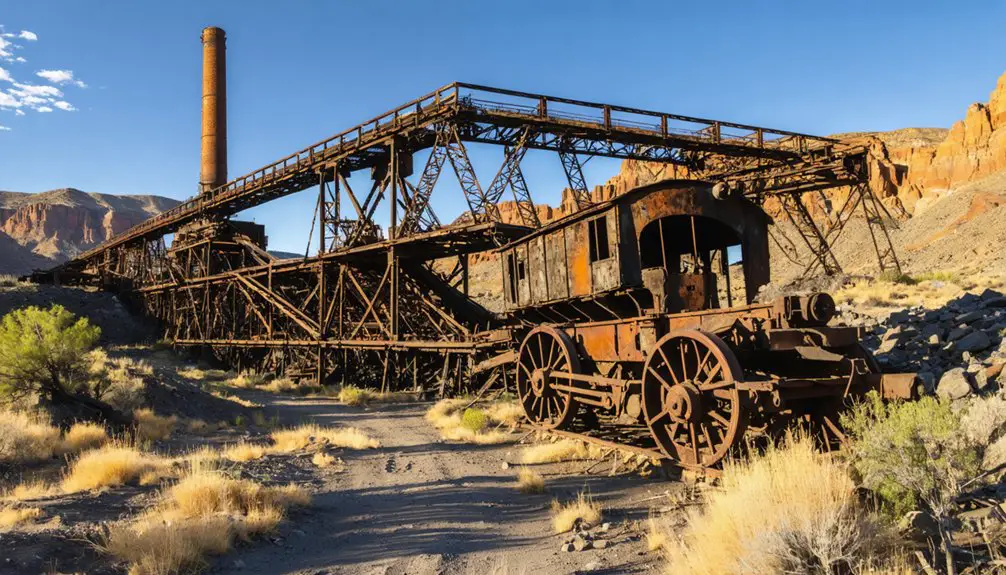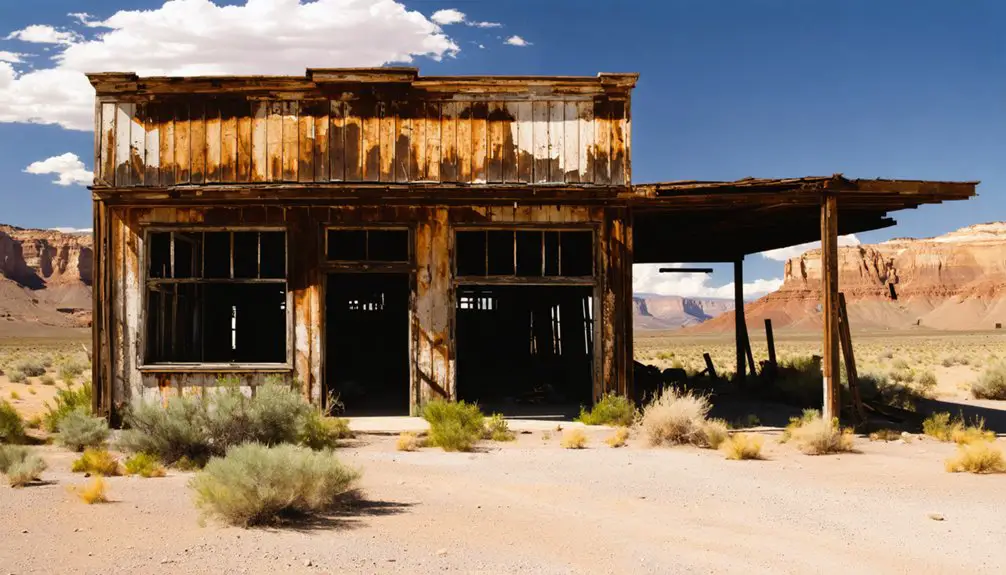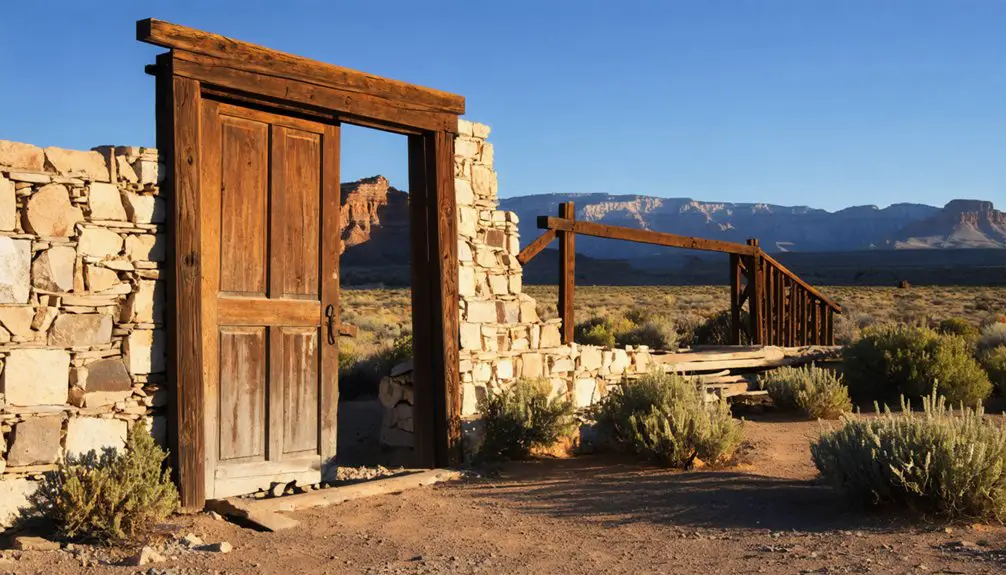You’ll find Coal City‘s remains at 7,000 feet in Utah’s Carbon County, where it began as Oak Springs Bench in 1885. After George A. Storrs discovered coal in 1921, the settlement transformed from a farming community into a bustling mining town, complete with wooden boardwalks and stone buildings. Even heavyweight champion Jack Dempsey’s brief presence in 1923 couldn’t prevent its decline after Great Western Coal Mines went bankrupt in 1926. The ghost town’s stone ruins hold fascinating stories of boom-and-bust ambitions.
Key Takeaways
- Coal City, Utah was established in 1921 as a mining town after George A. Storrs discovered rich coal deposits in the area.
- The town peaked with 70 residents and briefly gained fame when heavyweight champion Jack Dempsey trained there in 1923.
- Essential buildings included a brick schoolhouse, bakery, stone mercantile store, and wooden homes connected by boardwalks.
- The Great Western Coal Mines Company’s bankruptcy in 1926 and the Great Depression led to the town’s economic decline.
- By 1940, Coal City was largely abandoned due to mining operation failures and logistical challenges from lack of railroad access.
Origins and Early Settlement Days
While many Utah mining towns sprouted up near existing railroad lines, Coal City‘s story began differently in 1885 as an agricultural settlement called Oak Springs Bench.
You’ll find its origins at 7,000 feet elevation near Gordon Creek, where Alfred Grames first settled as a squatter and trapper. Despite the rugged terrain bounded by the Gentry Mountains, early settlers tried their hand at farming and ranching.
Settlement struggles quickly became apparent as the harsh elevation made agriculture nearly impossible. Early residents lived in basic wooden houses lined with compoboard, while many made do with tents. The first school classes were held in a simple log cabin in 1925. To avoid confusion with other locations, the town was listed in place name disambiguation records.
Life at 7,000 feet proved too harsh for farming, forcing settlers into simple wooden shelters and makeshift tent homes.
As farming proved unsustainable, the discovery of coal sparked a shift, though the area’s remote location and distance from railroads initially limited mining development.
The Birth of a Mining Town
You’ll find Coal City’s earliest settlers living in makeshift tent communities while they worked to establish the mining infrastructure in 1921.
The discovery of rich coal deposits by George A. Storrs transformed this temporary settlement into a promising mining venture, leading to the official platting of Coal City and incorporation of the Great Western Coal Mines Company that same year.
Your understanding of these pivotal moments would be incomplete without noting how the initial challenges of limited transportation and basic amenities were gradually overcome through the development of permanent housing, a school system, and eventually railroad connectivity. The completion of the Union Pacific Railroad in 1869 had already demonstrated how rail access could dramatically boost coal mining operations and immigration in Utah.
Like many other mines of the era facing a nationwide mining depression, Coal City struggled to maintain its economic viability throughout the 1920s.
Early Settlement Challenges
As settlers first ventured into what would become Coal City around 1885, they encountered a harsh landscape at 7,000 feet elevation that tested their resilience.
You’d have found these early pioneers, like Alfred Grames, living in primitive shelters – tents, dugouts, and basic log cabins with dirt floors that leaked during rainstorms. The settler hardships were amplified by the town’s remote location and limited access to supplies and markets.
The high elevation created significant farming limitations, making it nearly impossible to sustain successful agricultural operations. The threat of raiding Indians forced many settlers to build fortifications and live close together for protection. Like their neighbors in nearby Chalk Creek who discovered fallen wheat seeds, the settlers searched the land for any signs of agricultural potential.
While Clear Creek provided fresh water, the challenging terrain and short growing season forced many settlers to abandon their farming dreams. Those who stayed had to adapt to these unforgiving conditions, often turning to coal mining for survival.
Coal Discovery Changes Everything
The discovery of coal near Clear Creek in the late 1800s transformed the struggling settlement‘s destiny from a farming outpost to a budding mining town. You’d find early pioneers like George A. Storrs leading small-scale mining operations near the Gentry Mountains, where Gordon Creek cut through the landscape at 7,000 feet elevation.
Despite limited mining technology and challenging transportation logistics, the community’s resilience shone through as Coal City was officially platted in August 1921. The Great Western Coal Mines Company emerged two months later, bringing structure to the operations. Similar to the twelve coke ovens established in other Utah mining regions in 1872, Coal City’s development represented the territory’s growing industrial capabilities.
While the town never grew beyond 70 residents, you’d have seen a mix of tents and permanent buildings, including the Andreini and Calzani building, mercantile stores, and eventually a brick schoolhouse that replaced the original log structure.
Daily Life in Coal City
If you’d lived in Coal City during its heyday, your days would have revolved around the rhythms of the coal mines, with men heading underground for long shifts while families maintained modest wooden homes along the town’s boardwalks.
You’d have shopped at local grocery stores for basic supplies brought in by rail, perhaps stopping to chat with neighbors about community happenings or the latest mining news.
Your evenings might’ve found you at social gatherings in the Kiva club or local saloons, where live music and dancing offered relief from the day’s hard labor.
Much like the American Hotel in Saro Gordo, these gathering spots served as the heart of community life and entertainment.
The darker side of town life played out in tunnels beneath buildings, where opium dens and brothels operated in secret.
Mining Family Routines
Living in Coal City meant adapting to a schedule entirely dictated by the coal mine’s operations, where families structured their daily routines around the demanding shifts of underground work.
You’d find mining schedules controlling every aspect of daily life, while family support networks helped everyone cope with the challenging lifestyle.
Here’s how your typical day would unfold in Coal City:
- Men would head underground for long, physically demanding shifts while women managed household duties.
- You’d send your children to the local school while juggling domestic responsibilities.
- Your family would tend to small garden plots during off-hours, mainly growing flowers or fruit trees.
- You’d rely on company stores for necessities, with your wages carefully budgeted for rent, food, and basic expenses.
During winter months, families saw their income rise due to increased coal demand, allowing them to purchase extra Christmas gifts and supplies.
Store and Social Life
While mining operations dominated work life in Coal City, social interactions centered around Andreini’s Store, which opened in 1925 after taking over the former Great Western Coal Mines Company office building.
You’d find miners and their families gathering at this stone structure for more than just weekly supplies – it served as the heart of community life in this remote town of about 70 residents.
Store interactions went beyond simple transactions. You could catch up on local news, discuss mining conditions, or join informal gatherings, especially during Jack Dempsey’s notable presence in the early 1920s.
The store’s owner, Eugene Andreini, wasn’t just a merchant – he was an essential community figure who adapted his inventory to the town’s boom-and-bust cycles, ensuring necessary goods reached this isolated settlement despite challenging wagon transport.
The Jack Dempsey Connection
Boxing legend Jack Dempsey brought a burst of fame to Coal City in 1923, temporarily transforming the small mining town into “Dempsey City” during his stay. His presence created a buzz of excitement and economic potential, with locals hoping to capitalize on his celebrity impact.
In 1923, heavyweight champion Jack Dempsey turned a quiet mining town into Dempsey City, sparking dreams of prosperity among locals.
Here’s how Dempsey’s influence shaped the town:
- He trained in a converted stone building, drawing attention to the remote mining community.
- His brother Bernard actively promoted potential mining investments.
- George A. Storrs and other promoters pursued Dempsey’s financial backing.
- The town briefly enjoyed the nickname “Coal City with a punch behind it.”
The champion’s decision not to invest in February 1924 led to disappointment among residents, and the town reverted to its original name.
This episode exemplifies how sports celebrities could influence frontier communities’ economic aspirations in the early 20th century.
Mining Operations and Development

Although Coal City originated as Oak Springs Bench in 1885, its destiny shifted from farming to mining after the discovery of valuable coal deposits at its 7,000-foot elevation.
When George A. Storrs established the Great Western Coal Mines Company in 1921, mining techniques remained relatively basic, with coal being hauled by wagon to distant railroads.
The community dynamics centered around a population of about 70 residents, who initially lived in tents before constructing more permanent structures.
You’ll find that mining operations were less intensive than neighboring towns, giving residents a measure of independence.
Eugene Andreini’s 1922 stone building served as both the company office and later a mercantile store, while a brick schoolhouse, stores, and bakery supported the growing community by 1927.
Architecture and Infrastructure
Today’s remaining ruins of Coal City reveal a thoughtful blend of architectural approaches that served both practicality and permanence.
You’ll find distinct architectural styles reflected in the roofless cut-rock store building and collapsed wooden residential structures, showcasing the town’s infrastructure planning priorities.
- Rock and stone masonry dominated commercial buildings, while wood-frame construction was used for homes.
- Fancy concrete work around steps and foundations demonstrates attention to architectural detail.
- Infrastructure included wooden sidewalks, rock-walled cisterns, and a compact town layout.
- Civic amenities featured a combined post office and school, plus a company store with bakery.
The ruins tell a story of careful design choices, where durability met function in this early 20th-century mining community, even as nature slowly reclaims the site.
Economic Challenges and Decline

While Coal City’s infrastructure showcased thoughtful planning and design, the town’s economic foundation proved far more fragile.
You’ll find that the community’s fate was sealed by a perfect storm of challenges in the 1920s and 1930s. When George A. Storrs faced mail fraud charges in 1926, followed by Great Western Coal Mines Company’s bankruptcy, it triggered a cascade of economic instability.
Though mining resumed intermittently, the town couldn’t overcome its isolation from railroads and fierce competition from larger operations in National and Consumers. Labor migration accelerated as the Great Depression hit, and coal production declined sharply after 1935.
The town’s population, once reaching 70 residents, dwindled rapidly. By 1940, Coal City’s dream of becoming a thriving mining community had vanished into the Utah wilderness.
The Path to Abandonment
Once the economic pressures of the mid-1920s took hold, Coal City’s path to abandonment accelerated steadily.
Economic turbulence in the mid-1920s pushed Coal City down an irreversible path toward abandonment and desolation.
You’ll find that several key abandonment factors converged to seal the town’s fate, transforming it into the ghost town you see today.
- The Great Western Coal Mines’ bankruptcy in 1926 dealt a devastating blow, shattering community confidence and economic stability.
- Mining operations couldn’t overcome the logistical challenges of operating without nearby railroad access.
- The Great Depression’s impact on coal demand further weakened the town’s already fragile economy.
- By 1935, coal production had dwindled considerably, leading to a mass exodus.
Present-Day Remnants and Historical Significance

Despite decades of abandonment, Coal City’s remnants offer fascinating glimpses into Utah’s mining heritage.
You’ll find the 1922 Andreini and Calzani stone building still standing, though present day exploration is challenging due to thick brush and thorned vegetation that’s reclaimed the site. Near Gordon Creek, scattered foundations hint at the once-bustling community that included a school, company store, and bakery.
The town’s significance extends beyond its physical remains. Originally known as Oak Springs Bench, then Cedar Mesa Ranch, Coal City evolved from farming roots into a mining hub by 1921.
Though it never achieved large-scale success, the site played a unique role in Utah’s coal industry and even briefly gained fame as “Dempseyville” when boxer Jack Dempsey trained there in 1923.
Historical preservation remains minimal, with most structures succumbing to time and nature.
Frequently Asked Questions
What Wildlife and Natural Hazards Exist in Coal City Today?
You’ll find wildlife encounters with deer, elk, bears, and mountain lions, while facing natural hazards like water scarcity, flooding risks, and harsh desert conditions that affect both animals and habitat.
Are There Any Documented Paranormal Activities or Ghost Stories From Coal City?
Like a silent mine shaft, you won’t find documented haunted history here. Despite Coal City’s ghostly appearance, there aren’t any verified local legends or paranormal activities in historical records.
Can Visitors Legally Explore and Photograph the Remaining Structures?
You’ll need explicit permission from property owners for legal access and photography since most structures are on private land. Don’t enter without authorization, as you could face trespassing charges.
What Artifacts Have Been Discovered and Preserved From Coal City?
You’ll find treasured remnants like Chinese currency, porcelain bowls, mining machinery, and domestic items. These artifacts tell stories through preserved foundations, burial grounds, and scattered industrial equipment across the site.
How Accessible Is Coal City During Winter Months?
You won’t be able to access the site during winter due to safety concerns, gated restrictions, and heavy snowfall. You’ll need special permits and snow-capable vehicles if you’re determined to attempt it.
References
- https://en.wikipedia.org/wiki/Coal_City
- https://kids.kiddle.co/Coal_City
- https://jacobbarlow.com/2020/03/28/coal-city-utah/
- https://www.legendsofamerica.com/coal-city-utah/
- https://www.familysearch.org/en/wiki/Coal_City
- https://utahrails.net/utahcoal/A-Brief-History-of-Carbon-County_1930_Chapter-4_Town-Histories.htm
- https://www.legendsofamerica.com/national-utah-ghost-town/
- https://historytogo.utah.gov/old-king-coal/
- https://www.gem.wiki/Utah_and_coal
- https://utahrails.net/mining/brewster.php



